If you’re looking for serious comfort food, look no further than our slow cooker Dublin Coddle. This traditional Irish dish of slow cooked bacon, sausage, and potatoes is like a warm blanket on a cold winter day.

When it comes to St. Patrick’s Day cooking, we always find ourselves with a bit of a problem. Do we make the classic American St. Patrick’s Day dish: Corned Beef and Cabbage, or do we make something that is actually, authentically Irish?
We may have found the perfect answer to combining the two in this classic and comforting Irish dish.
Dublin Coddle: Serious Irish Comfort Food
If you’re looking for a warm bowl of comfort food, we have a bowl of Dublin Coddle with your name on it.
The dish originated in the 1700s in Ireland and is still considered a favorite in Dublin and across Ireland.
One story about how coddle became so popular goes like this: an Irish wife could put a pot of Dublin coddle on the stove in the evening and then go to bed.
The stew would be simmering and hot, ready just in time for her husband when he came home from a long night with his buddies at the local pub.
A Catholic Irish Dish
In the time when Catholics didn’t eat meat on Fridays, coddles were often eaten as a Thursday night dinner. They were the perfect dish for the mother of the household to use up any leftover sausages and bacon that she had laying around the pantry.
Nowadays, it’s the perfect slow-cooking dish when you want to prep a meal ahead of time and forget about it.
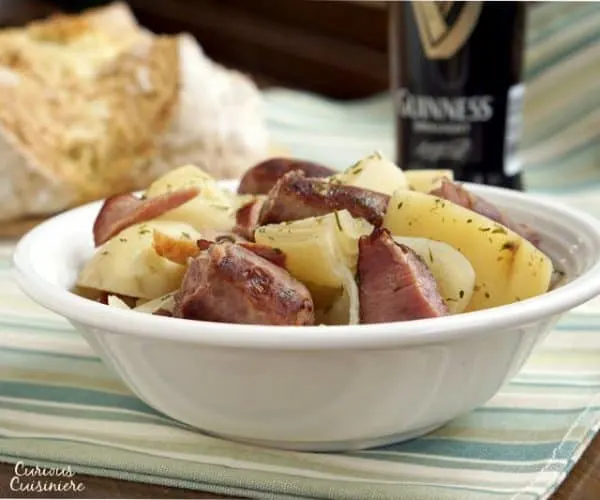
Our Slow Cooker Dublin Coddle Recipe
Traditional Dublin coddle is cooked in a Dutch oven. It is a one-pot meal where you can saute your meat, layer your ingredients, and then pop it into the oven on a low heat (around 300F) for 3-5 hours (or simmer it on a low stove).
If you’d like to make your coddle this way, go ahead. The ingredients and the rest of the instructions are the same.
But, to make Dublin coddle even easier, we decided to call in the help of our trusty slow cooker.
With just a quick sauteing of the meat, you can dump your ingredients and be on your way.
Dinner will be waiting for you when you return.
Serving Dublin Coddle
As with any classic Irish dish, you’ll want to serve your Dublin Coddle with a hearty pint of Guinness and lots of Irish Soda bread!
What else did you think we’d recommend?
Slow Cooker Dublin Coddle
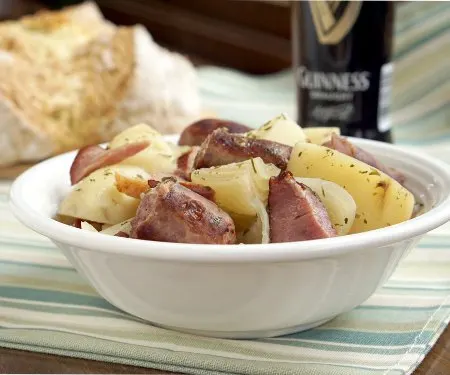
A comforting Irish stew that uses the slow cooker to put dinner on the table with minimal effort. This traditional Irish dish is perfect winter comfort food!
Ingredients
- 1 lb pork sausages
- 1 lb thick cut bacon, chopped
- 3 onions, halved and quartered
- 2 lb waxy potatoes (like red potatoes), peeled and quartered
- 1 ½ Tbsp parsley, dry
- 4 c warm water
- Salt and pepper (to taste)
Instructions
- In a large skillet, grill the sausages and bacon over medium heat until golden. Remove from the heat and cut each sausage into 3-4 pieces.
- In the bowl of your slow cooker layer (in this order) onions, bacon, sausage pieces, and potatoes, sprinkling a little parsley between each layer.
- Pour the water over top of the ingredients.
- Cover the slow cooker and cook on low for 5-6 hours or on high for 3-4 hours.
- Taste the broth before serving and add salt and pepper as desired.
Notes
If you would like to prepare the coddle in the traditional, oven fashion, layer the ingredients into a Dutch oven as directed. Bring the mixture to a boil. Then, place the, covered, coddle into a preheated 300F oven and cook for 3-5 hours.
Nutrition Information:
Yield:
6Serving Size:
1/6 of recipeAmount Per Serving: Calories: 761
If you liked this recipe, here are some similar dishes you may enjoy!

Sarah founded Curious in 2010 as a way to save her recipe creations and share culinary experiences. Her love for cultural cuisines was instilled early by her French Canadian Grandmother. Her experience in the kitchen and in recipe development comes from over 10 years working in professional kitchens. She has traveled extensively and enjoys bringing the flavors of her travels back to create easy-to-make recipes.
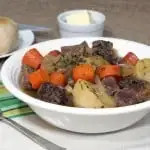

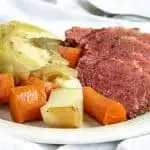


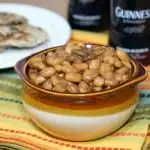

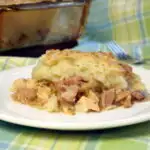
Megan
Saturday 30th of December 2023
Not sure if these comments are checked anymore but thought it was worth asking.
I'm a uni student and trying to think sensibly about portions in terms of what I can realistically eat in one sitting, and then safely storing the leftovers in the fridge (I already learned the hard way about how poorly potatoes freeze!)
Would this be possible to do by halving the recipe, and would that affect the cooking time in the slow cooker?
Sarah - Curious Cuisiniere
Monday 8th of January 2024
Hi Megan. The recipe can be easily halved. Cooking time would depend on the size of your slow cooker. If you have a smaller slow cooker that fits the size of ingredients you have, I would think the times would be roughly same. But if you are only filling your slow cooker half way, I would check it closer to 2.5 hours for high and 4 hours for low. (Although if you're using a larger slow cooker, you may still need the longer time on low because some larger slow cookers take 5 hours to hit max temperature.)
Bastun
Monday 16th of August 2021
If you're making Dublin Coddle, you don't cut the sausages before putting them in the saucepan/cooker. Just put them in whole. It would *not* be traditional to brown the sausages first, either (though it is done).
Adding Guinness (or any stout) to the mix? Just NO! It's supposed to be a light-coloured broth when served. (By all means serve *with* stout - we even have really good Irish craft stouts, now, in addition to Diageo PLC's Guinness!)
The photos look like there's not much broth there? I'd add more liquid (and probably cheat by using a potato and leek or even a chicken soup)!
Last point, traditionally, this would never have been cooked in an oven - it's a "working class" dish and the oven (if you had one) was reserved for special occasions; it's a stove-top dish.
Sarah Ozimek
Friday 20th of August 2021
Hi Bastun. Thanks for sharing. (Although I am a bit confused, because we don't have beer in our recipe.) We've come across many recipes that use the browning method and cook the dish in the oven, but that is an interesting point about the early historical version.
Linda Halle
Friday 28th of August 2020
Hello. Could I add a room temperature cup of Guinness and three cups of water? Thanks!
Sarah Ozimek
Sunday 30th of August 2020
Yes. That would be delicious! Enjoy!
Warren Taylor
Tuesday 10th of March 2020
The pictures of the Coddle look to have ham rather then bacon is it made both ways.Either way looks good and I am sure I will like them both.
Thank You
Speedwell
Thursday 13th of January 2022
@Sarah Ozimek,
I'm an American married to a Northern Irishman, living in rural Donegal. Here in Ireland, our bacon is back bacon (from the loin), not the belly bacon sold as "bacon" in America (we call that "streaky bacon"). When my husband lived with me for a couple of years in Texas, we cured our own Irish bacon, but any dry-cured pork will do the job so long as it is not smoked. I used to get cured, unsmoked pork chops from the German descendants in Central Texas. Even unsmoked ham will do in a pinch.
The pork sausages we have here are more difficult to find in America. It is almost worth making your own sausage balls (no need to stuff into skins for coddle) with the simple recipe at this link from an Ireland-based grocery chain (a good straightforward home-cured bacon is here too): https://www.londis.ie/homemade-irish-breakfast-sausages-and-rashers/ Both the sausage and bacon are suitable for vacuum-packing and freezing at home, by the way. Slainte :)
Sarah Ozimek
Wednesday 11th of March 2020
Hi Warren. You are correct, some of those pieces of back do look similar to ham. They are actually bacon though, just really thick cut from the end of a slab that we were slicing ourselves. Enjoy!